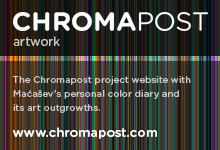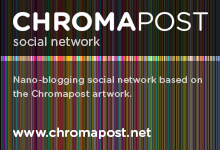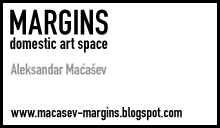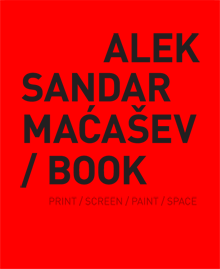Interview for City Magazine, Belgrade
September 2013
Written by Anica Tucakov
During your visit to Belgrade you will present the Chromapost project in four parts, which beside the participatory character, involve a serious research and analytical treatment of color as information. Tell us about the timeline of this personal online diary.
This project started as many others do. Out of frustration. I realized I was missing something big when it came to the use of color in my art and design practice. I wanted to get rid of everything I had been taught and to establish a very personal relation to color. The nano-blogging format (let’s say it’s a step beyond the micro-blogging in terms of compression of information) turned out to be ideal. At the end of each day I try to express my daily emotional experience through a single color and thus after a while make an honest link between color and my own emotions. It all really started as a simple blog. After a while I started using that color archive as material for generating artwork, so it expanded into a regular website (www.chromapost.com) and recently it has gotten a social network offshoot (www.chromapost.net).
The Chromapost installation was a part of the Armory Show 2012. It’s quite an impressive fact especially because it was recommended as one of the must-see works that year. How did that work come to be and what was the reaction to it?
One of the outgrowths of the project was a 350 foot long printed installation in Dumbo, Brooklyn. The installation contained two years of my chromaposts, about 730 colors, and it was produced by ArtBridge and the Dumbo Arts Festival. Since it was positioned between the Brooklyn Bridge and the Manhattan Bridge, and thanks to its scope and duration (one year) the work garnered a lot of attention and it marked the whole neighborhood in a way. The installation was included in the Art Walk section of the Armory Show, one of the biggest art events in town. The Huffington Post included the installation in their must-see selection among five other works.
How did an online project get its physical outgrowth? Did you have such an option in mind when you began, or did the proposal come from outside?
Well, the first thing that came to my mind when I started it was that it could be a social network. That one particular installation happened thanks to a set of fortunate circumstances. Dumbo Arts Festival offered a 350 foot long blank outdoor strip to ArtBridge. It is a pretty challenging format and it’s not easy to find a suitable artwork for it. The ArtBridge staff flipped through my book, they spotted one of the very early Chromapost exhibits from 2010 and that turned out to be exactly what they were looking for. After that, I created a variety of other physical outgrowths like paintings and posters. One of the posters ‘Chromapost 4YRS’ will be available in Mikser House during the Chromapost Sessions. The ArtBridge-produced Dumbo installation will be recycled into bags by Brooklyn Industries this autumn.
What are the possibilities of presenting Chromapost outside of New York or Belgrade?
The project is very flexible and the possibilities are endless. First of all, it’s an online project so it’s accessible from wherever. There are some proposals for different outgrowths, but I would love to talk about them when they happen. I find presenting the project in different cultures very inspiring. In Belgrade I had two lectures, one presentation and a collaborative on-the-spot art making. It is all part of a single story. The lectures were about how various influences (culture, visual communication, personal memories, art history, commerce and art theory) affect our color perception, our color preferences and our color expression. Those lectures were an introduction to the presentation of the Chromapost project whose central theme is getting rid of those influences and creating your own color vocabulary. In the final lecture all the participants could choose a color based on their own emotions and build it into a group emotional snapshot.
Previously your work was known for the very sharp social commentaries where the concepts, production, and expression were very bold. Do you still work with social and political issues?
Our visual space is flooded by various activist initiatives and unfortunately we became quite immune. Far from the fact that I lost my activist urge, but I channel it through different means like direct help. When you realize that one way became inefficient you use another one.
For a while you have been living and working in New York where you are a part of the art scene. The crisis in Belgrade manifested itself as a lack of clearly articulated voices that should point to social anomalies. What’s the situation in the city where you live now, considering that it is a world crossroad?
That requires a rather complex analysis, but basically in New York everything is happening all the time. Sounds exaggerated, but it often feels that way. On the other hand you have this enormous shift in treating art only as a commodity. Someone said a couple of years ago that art is not valued by critics, but by Wall Street. The epicenter is Chelsea, which has the most galleries per city block in the world. Prices for established art are astronomic and everything looks like a morbid celebration of liberal capitalism. New and vital art hasn’t vanished, far from that. It just moved from Manhattan to Brooklyn.
You often collaborate with various organizations on projects in Belgrade. Based on your occasional visits what’s your view of the present state of visual arts in Belgrade and Serbia?
I’m most interested in the youngest generations of artists. And there are quite a few. They are talented and professional and they don’t wait to be given anything, but they fight for their own space and audience. That kind of vitality is not very visible to the wider audience. Unfortunately I also see the remnants of the ‘good old days’ and one of them is a normative way of thinking - “I am an artist, I make art from 9 to 5 and I wait from the state or whomever to pay me for that.” Well, if you’re an artist your primary urge is to make art and you will always find a way to do it. Everything else is just an excuse.
Your professional partner in Belgrade is mainly Mikser. Tell us something more about your collaboration that also included production of “Waiting for the Sun” mural.
Actually, it’s not only Mikser. I respond to many interesting proposals because this cultural space is very dear to me. Mikser is probably the most visible. Collaboration on the “Waiting for the Sun” mural was a great experience. One person picked one of my earlier works that fit on the wall perfectly, another person along with several assistants did the actual execution, and all that happened in collaboration with a paint manufacturer. It was all very similar to the production of the Chromapost installation.
Link to the original interview in Serbian
September 2013
Written by Anica Tucakov
During your visit to Belgrade you will present the Chromapost project in four parts, which beside the participatory character, involve a serious research and analytical treatment of color as information. Tell us about the timeline of this personal online diary.
This project started as many others do. Out of frustration. I realized I was missing something big when it came to the use of color in my art and design practice. I wanted to get rid of everything I had been taught and to establish a very personal relation to color. The nano-blogging format (let’s say it’s a step beyond the micro-blogging in terms of compression of information) turned out to be ideal. At the end of each day I try to express my daily emotional experience through a single color and thus after a while make an honest link between color and my own emotions. It all really started as a simple blog. After a while I started using that color archive as material for generating artwork, so it expanded into a regular website (www.chromapost.com) and recently it has gotten a social network offshoot (www.chromapost.net).
The Chromapost installation was a part of the Armory Show 2012. It’s quite an impressive fact especially because it was recommended as one of the must-see works that year. How did that work come to be and what was the reaction to it?
One of the outgrowths of the project was a 350 foot long printed installation in Dumbo, Brooklyn. The installation contained two years of my chromaposts, about 730 colors, and it was produced by ArtBridge and the Dumbo Arts Festival. Since it was positioned between the Brooklyn Bridge and the Manhattan Bridge, and thanks to its scope and duration (one year) the work garnered a lot of attention and it marked the whole neighborhood in a way. The installation was included in the Art Walk section of the Armory Show, one of the biggest art events in town. The Huffington Post included the installation in their must-see selection among five other works.
How did an online project get its physical outgrowth? Did you have such an option in mind when you began, or did the proposal come from outside?
Well, the first thing that came to my mind when I started it was that it could be a social network. That one particular installation happened thanks to a set of fortunate circumstances. Dumbo Arts Festival offered a 350 foot long blank outdoor strip to ArtBridge. It is a pretty challenging format and it’s not easy to find a suitable artwork for it. The ArtBridge staff flipped through my book, they spotted one of the very early Chromapost exhibits from 2010 and that turned out to be exactly what they were looking for. After that, I created a variety of other physical outgrowths like paintings and posters. One of the posters ‘Chromapost 4YRS’ will be available in Mikser House during the Chromapost Sessions. The ArtBridge-produced Dumbo installation will be recycled into bags by Brooklyn Industries this autumn.
What are the possibilities of presenting Chromapost outside of New York or Belgrade?
The project is very flexible and the possibilities are endless. First of all, it’s an online project so it’s accessible from wherever. There are some proposals for different outgrowths, but I would love to talk about them when they happen. I find presenting the project in different cultures very inspiring. In Belgrade I had two lectures, one presentation and a collaborative on-the-spot art making. It is all part of a single story. The lectures were about how various influences (culture, visual communication, personal memories, art history, commerce and art theory) affect our color perception, our color preferences and our color expression. Those lectures were an introduction to the presentation of the Chromapost project whose central theme is getting rid of those influences and creating your own color vocabulary. In the final lecture all the participants could choose a color based on their own emotions and build it into a group emotional snapshot.
Previously your work was known for the very sharp social commentaries where the concepts, production, and expression were very bold. Do you still work with social and political issues?
Our visual space is flooded by various activist initiatives and unfortunately we became quite immune. Far from the fact that I lost my activist urge, but I channel it through different means like direct help. When you realize that one way became inefficient you use another one.
For a while you have been living and working in New York where you are a part of the art scene. The crisis in Belgrade manifested itself as a lack of clearly articulated voices that should point to social anomalies. What’s the situation in the city where you live now, considering that it is a world crossroad?
That requires a rather complex analysis, but basically in New York everything is happening all the time. Sounds exaggerated, but it often feels that way. On the other hand you have this enormous shift in treating art only as a commodity. Someone said a couple of years ago that art is not valued by critics, but by Wall Street. The epicenter is Chelsea, which has the most galleries per city block in the world. Prices for established art are astronomic and everything looks like a morbid celebration of liberal capitalism. New and vital art hasn’t vanished, far from that. It just moved from Manhattan to Brooklyn.
You often collaborate with various organizations on projects in Belgrade. Based on your occasional visits what’s your view of the present state of visual arts in Belgrade and Serbia?
I’m most interested in the youngest generations of artists. And there are quite a few. They are talented and professional and they don’t wait to be given anything, but they fight for their own space and audience. That kind of vitality is not very visible to the wider audience. Unfortunately I also see the remnants of the ‘good old days’ and one of them is a normative way of thinking - “I am an artist, I make art from 9 to 5 and I wait from the state or whomever to pay me for that.” Well, if you’re an artist your primary urge is to make art and you will always find a way to do it. Everything else is just an excuse.
Your professional partner in Belgrade is mainly Mikser. Tell us something more about your collaboration that also included production of “Waiting for the Sun” mural.
Actually, it’s not only Mikser. I respond to many interesting proposals because this cultural space is very dear to me. Mikser is probably the most visible. Collaboration on the “Waiting for the Sun” mural was a great experience. One person picked one of my earlier works that fit on the wall perfectly, another person along with several assistants did the actual execution, and all that happened in collaboration with a paint manufacturer. It was all very similar to the production of the Chromapost installation.
Link to the original interview in Serbian







No comments:
Post a Comment